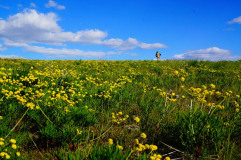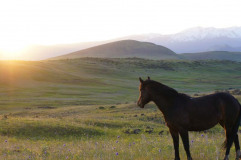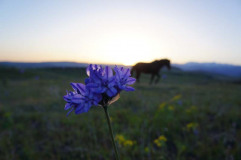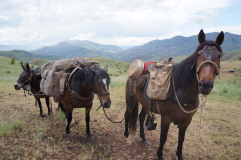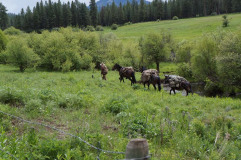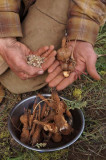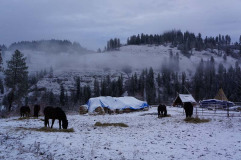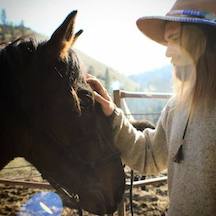No products in the cart.
Life on a Packstring
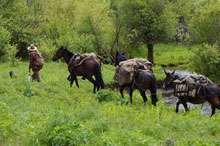
And Walking with the Wildflowers
Story and photos by Michael Ridge
Thigh-high muddy waters from spring runoff had transformed this intermittent creek into a raging river, and I was in the middle of it. Under me, the horse struggled to find footing among the ever-shifting bed of rocks. Suddenly, he stumbled into the deepest section, dipping me belly-deep in ice-cold water. My pack horse followed us, proud and confident, but on the tail end of the string, my smaller-than-average pack mule floated off the creek bottom and headed downstream, which only added to my certainty that I should have found an alternative route. But we pulled through! My buckskin pants were soaked and sagged off my hips, and my adrenaline pumped, because I knew we were not done with this seemingly impossible obstacle.
Across the wild waters, my dog waited nervously on the bank we had just left. I tied my packers to the nearest tree and mounted my riding horse to swim across the creek again and fetch my dog. She was smart enough to know she could never cross by herself, but also had no interest in riding a horse. Getting her to the other side meant I crossed that creek three times. The way I figured it, there was no harm in being soaked to the bone, because it was a rainy day to begin with. I was just glad the hard part was over. Still, there were ten more miles to ride before we made our next camp along the Idaho side of the Snake River.
Hells Canyon country is far less forgiving than most terrain. Whether it’s in or out, up or down, cinch tight and hold on to your hat.
It was early May when I made it to the Oxbow Dam and was filled with a brief sense of security, because we had left the wilderness and entered a somewhat touristy zone. But my dog-and-pony show was welcomed with yet more heavy rain. I found a cluster of elderberry trees to tie off to, and unpacked the horses. I don’t normally tie my horses where I plan to make my shelter, but I had to unpack in such a way that my gear and equipment would stay dry. First to come off the packs were my canvas tarps, which I immediately used to create a canopy above the horses. As I was applying tension to my cord, the hollow elderberry branch I had fastened to snapped and dropped the corner of the tarp to the ground. This made my mule uneasy and she relieved herself right where I planned to make my bed: the exact reason you don’t tie up where you plan to lie down.
A huge patch of edible breadroots.
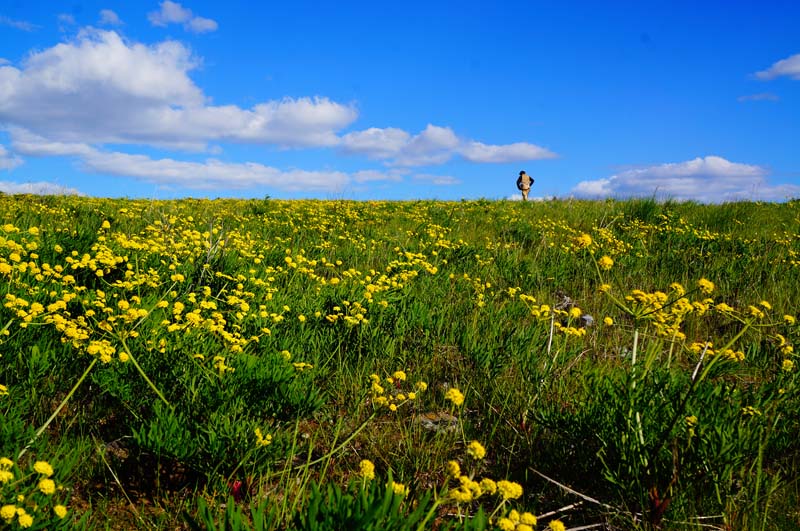
Near Hells Canyon.
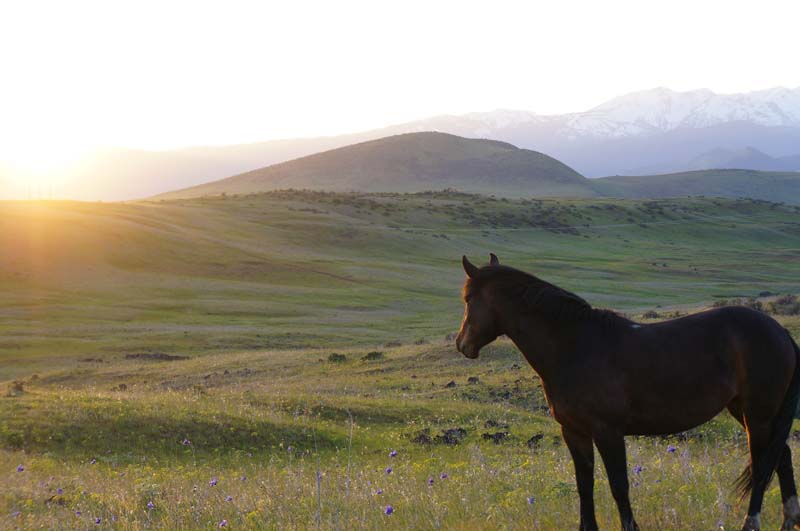
An edible wildflower called brodiea, near Cuddy Mountain.
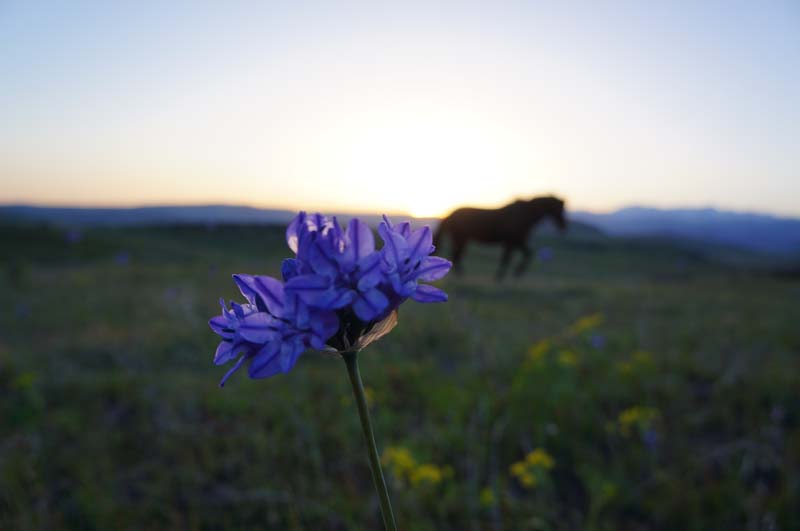
The author's pack string emerges from Hells Canyon.
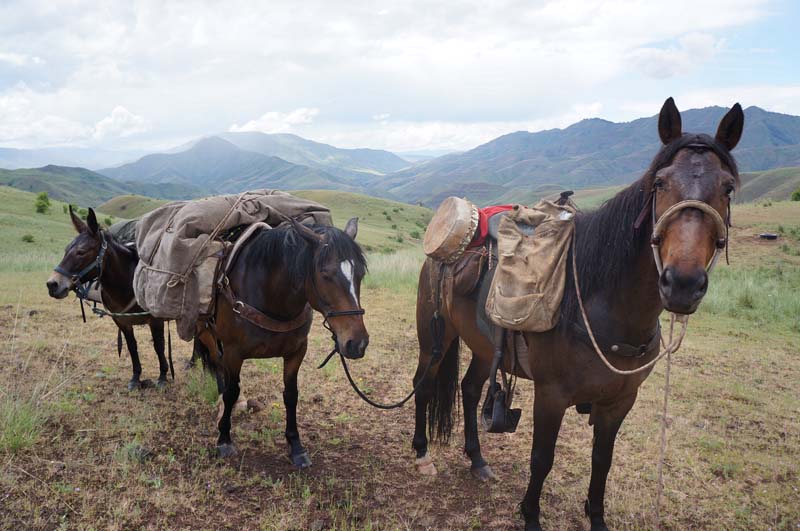
Michael leads his pack string to make camp west of Council.
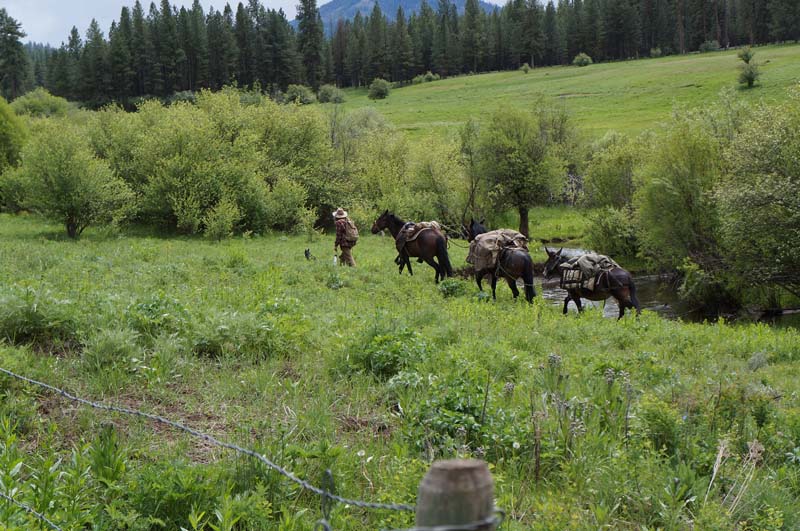
Seed and roots of edible breadroots.
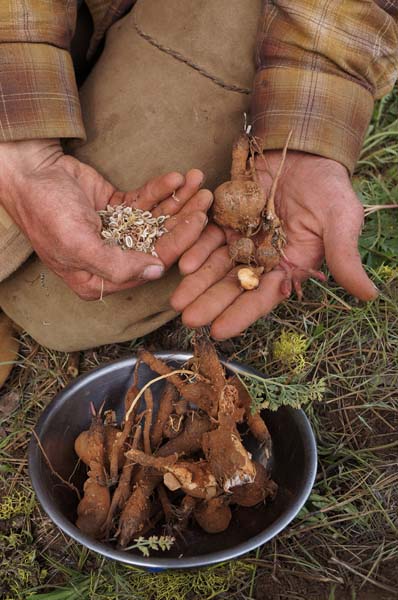
Winter camp on South Fork of Clearwater River near Stites.
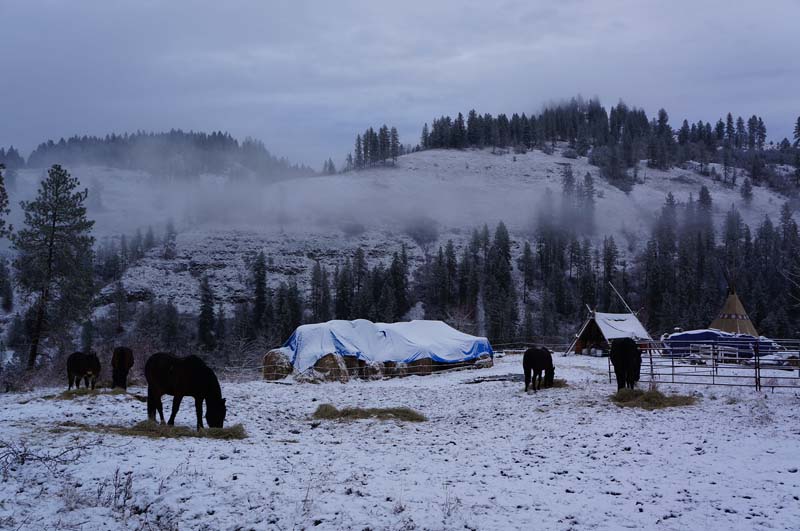
I finished unpacking and ventured into the storm in my manure painted-shoes to picket the horses on fresh green grass. Horses always come first in my camp. They carry the weight and work many hours of travel, when they would much prefer to be grazing. Only after the ponies were properly cared for did I begin to make my shelter, gather firewood, filter water, dry my soaking clothes, and finally cook food. This might seem like a lot of work, especially when done alone, but it’s good work, and necessary work at that. My horses bring me to wild places many people cannot go, and I’m very grateful for all they offer a man with their willing hearts.
I do this year after year, for the love of all things wild. I do it to be part of the ever-shifting story of the landscape’s seasons, and to give my critters and me the best life I know.
When I packed up the camp in preparation for another day of travel, I revisited all the patches of bare ground made by my horses while they were picketed. I brought along my shovel and a handful of seeds. I regularly gather a lot of seed, primarily native: everything from grasses to fruit trees to berry bushes, roots, and lilies. I plant seeds everywhere we make camp. One goal is to flip the otherwise negative impact horses can have when they’re contained into a positive impact. It feels good to leave each camp better than I found it. Tending the sites where we camp has become an ongoing act of restoration: a mission, so to speak. Cleaning nearby trees of deadwood for nice pitchy firewood helps the trees. Along with the deadfall, I gather up any trash left behind by previous campers. I always depart from a camp with a sense of accomplishment.
When you live on a packstring, you don’t need to seek out adventure, because it will find you. In 2019, the journeys that led me into Idaho’s wild lands of seemingly endless mountain ranges amounted to my sixth consecutive year of living and traveling by horse, leading a packstring. It’s been a wonderful journey to the unknown up ahead, and I can tell you it took quite a bit of work to get here.
When I was twenty-three and living an ordinary lifestyle, I committed to this path of a modern-day mountain man. I had no previous experience with horses and couldn’t even tell you which way the wind blew. Yet I raised and trained my horses myself, almost immediately after they were rounded up from the wild. I made my clothes from deer and elk skins, and decorated them with beads and antlers, quillwork, and braided horsehair. I learned to shoe my own horses, and have become an expert forager and hunter for meat. In the summer of 2019, I turned thirty. All the experiences I’ve now had in the wild have contributed to my character development. What I discovered out here in the vast wildlands of the West were things the towns below couldn’t offer. In turn, I now have something to offer those very communities.
My area of expertise is the wild foods that grow in abundance here in Idaho and the greater West. If you were to happen upon me in my element, you’d find yourself presented with a smile, kind words, and old knowledge hidden among the mountains, canyons, and plateaus.
This winter, after many crooked miles, I found myself camped in Stites. A kind local rancher had offered his off-the-grid plot of land with a year-round water source for our winter camp. Hay for horses and good bit of firewood were all I need to maintain comfort throughout the winter. Friends made here have all been encouraging and supportive. Once I was set up for winter, I looked for a place to plant some of the native seed I had collected on my travels. It’s important to plant the seeds before the winter freeze, so they can sprout come spring. My seed bundle is a collection of native companion plants mixed with a library of wild edible natives I gathered through the travel seasons.
This time, we planted in a very special place above the South Fork of the Clearwater River. It’s a site known as Battle Ridge, where General Howard executed an attack on a Nimiipuu (Nez Perce) encampment after riding across the prairie. Evidence of that 1877 battle still lingers on this site, in the form of man-made rock turrets designed to withstand cannon blasts. It felt very good to replant the first foods where they had been 143 years ago. A library of breadroots, lilies, berries, and fruit trees will claim their place once again in the turning of the seasons.
Months have passed since then. The winter freeze set in, and another sucessful year of gathering filled me with a sense of accomplishment. As I sit now beside the fire in my tipi, the venison stew boils away while I attempt to share a bit about my life with you. There is always something to accomplish and create through winter, so I’m busy every day, tanning deerskins into beautiful soft buckskin, because I can make just about everything I need with good braintanned deer skins. I make a variety of bags, jackets, moccasins, and pants. I also enjoy taking the extra time to bead these wild crafts and to braid horsehair gifts to share for all the support I’ve gained along the way.
There’s no telling how many years I’ll live like this before I’m through. Right now, there is no end in sight.
For me, it goes beyond beauty to witness all the critters and colors of the seasons as they morph and transform around me. Exposed to the elements year-round really ain’t so harsh when those very elements define your home.
You can find the author on Facebook and Instagram under the alliterative name, “Walking with Western Wildflowers,” as he makes his way through the wild and shares his journey.
This content is available for purchase. Please select from available options.
Register & Purchase Purchase Only
Register & Purchase Purchase Only

